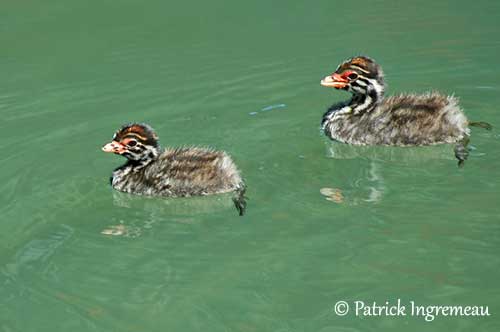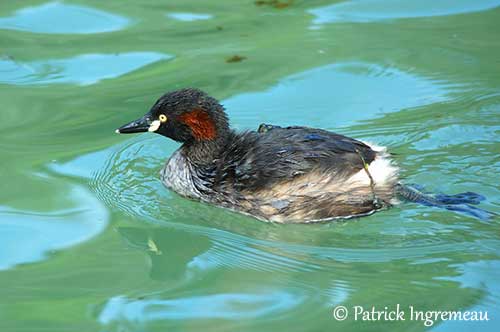
PROTECTION / THREATS / STATUS:
The Australasian Grebe is described as locally common throughout the large range.
The size of the population is unknown but it shows an increasing trend. In Australia, modification of wetlands may involve local declines or extinctions, but creation of artificial wetlands also helps this species.
The Australasian Grebe is not globally threatened, and the species is currently evaluated as Least Concern.
Fr: Grèbe australasien
Ang: Australasian Grebe - Australasian Little Grebe - Australasian Dabchick
All: Australischer Zwergtaucher
Esp: Zampullín Australiano
Ita: Tuffetto australasiatico
Nd: Australische Dodaars
Sd: australisk smådopping
Photographers:
John Anderson
John Anderson Photo Galleries
Jean Michel Fenerole
Photos d’Oiseaux du monde
Patrick Ingremeau
TAMANDUA
Ingo Waschkies
Bird Photography
Text by Nicole Bouglouan
Sources :
HANDBOOK OF THE BIRDS OF THE WORLD vol 1 by Josep del Hoyo-Andrew Elliot-Jordi Sargatal - Lynx Edicions - ISBN: 8487334105
Field Guide to Australian Birds by Michael Morcombe - Editeur: Steve Parish Publishing Pty Ltd – ISBN-10: 187628210X -ISBN-13: 978-1876282103 - 448 pages
The Graham Pizzey & Frank Knight Field Guide to the Birds of Australia - Publisher: HarperCollins Publishers (Australia) Pty Ltd; Reprint. Edition (1996) - ISBN-10: 020718013X - ISBN-13: 978-0207180132 - 528 pages
BIRDS OF AUSTRALIA by Peter Rowland – Ed: Louise Egerton - ISBN: 1864363436
Birds in backyards (Birds Australia and Australian Museum)
Wikipedia, the free encyclopaedia
Australasian Grebe
Tachybaptus novaehollandiae
Podicipediformes Order – Podicipedidae Family
INTRODUCTION:
The Australasian Grebe is found throughout Australia and on islands in the Pacific region. It is also present in New Zealand as self-introduced species. Six subspecies share the large range.
It is usually found in freshwater waterbodies, ponds, reservoirs and small waterways, but the breeding habitat requires vegetated shores. It feeds on small fish, crustaceans, molluscs and aquatic insects. It dives deeply and pursues some prey at water surface. This species is solitary nester and usually produces three broods per season. It nests on a floating platform anchored to the submerged vegetation.
The Australasian Grebe is not globally threatened, and is described as locally common throughout the range. The population is suspected to be increasing, but the island populations are not well known with more or less stable numbers.

DESCRIPTION OF THE BIRD:
Biometrics:
Length: 23-27 cm
Weight: 100-230 g
The Australasian Grebe in breeding plumage has brown-grey upperparts including the wings where a large white panel is visible on the flight-feathers, especially most of secondaries and basal primaries.
On the underparts, the underwing is pale grey with the same white panel. The breast is dark brown-grey. Sides and flanks are also brown-grey but with a tawny wash. The rear of the body is whitish buff and the belly is white.
Head and neck are glossy black to dark brown-grey, more blackish on the head. There is a large chestnut patch extending from the rear of the eye, above the ear-coverts to the base of the neck.
The short, black, pointed bill has whitish tip, and yellow to greenish-yellow gape patch. The eyes are yellow. Legs and lobbed feet are dark greenish-grey with yellowish tinge on inner tarsi.
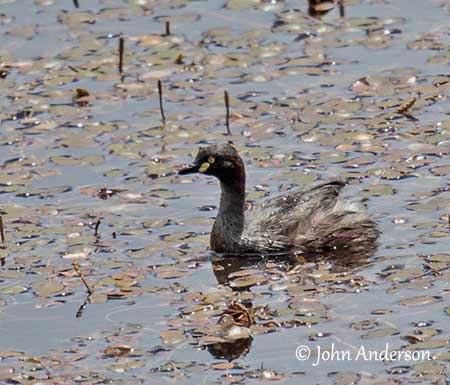
The non-breeding adult is grey-brown above, including head and central hindneck. Head sides and rest of the neck are pale brown to grey-buff. Face, chin and upper throat are often whiter, whereas the upper ear-coverts are washed greyish. Sides and flanks are tawny-buff with greyish tinge.
The bill is paler, like the gape patch.
Male and female have similar plumage, but the male is slightly larger.
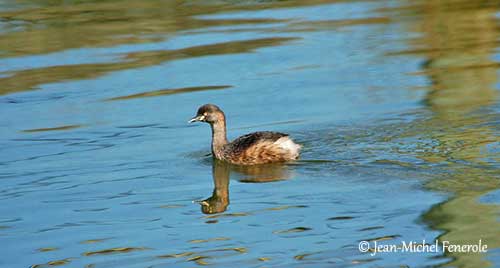
The juvenile resembles non-breeding adult, but it has black and whitish stripes on both face and neck. The eyes are slightly duller.
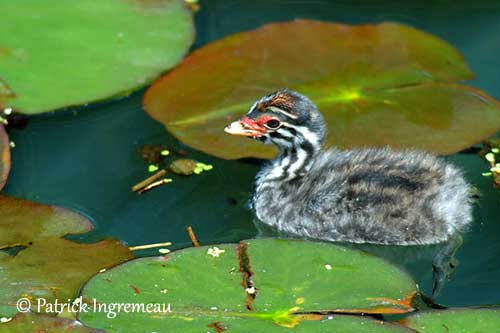
Chick
The chick has pale pink bill and dark eyes
SUBSPECIES AND RANGE:
The Australasian Grebe has six subspecies that slightly differ in size and coloration.
T.n. javanicus is found in Java.
T.n. fumosus occurs on Talaud Islands and Sangihe Islands (Indonesia).
T.n. incola is found in N New Guinea.
T.n. novaehollandiae (described above) occurs in S New Guinea, Australia, Tasmania and New Zealand.
T.n. leucosternos is found in Vanuatu and New Caledonia.
T.n. rennellianus occurs on Rennel Island (Solomon Island).
HABITAT:
The Australasian Grebe frequents a variety of wetland habitats such as freshwater ponds and lakes, small reservoirs at farms, slow-moving rivers and small waterways. It is also observed on temporary flood waters.
During the breeding season, it can be found mostly on vegetated shores where it builds the nest among reeds and other aquatic plants.
The species is visible both in lowlands and hills, up to 1,500 metres of elevation. In New Guinea, it is found at least at 3,200 metres.
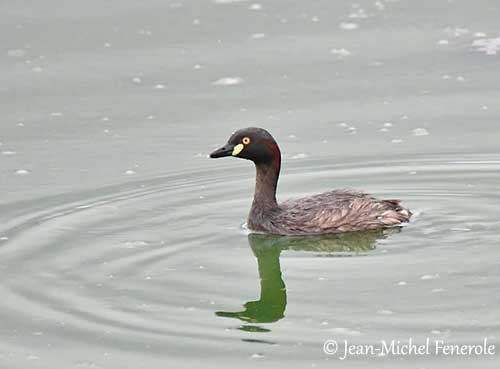
T.n. leucosternos
New Caledonia
CALLS AND SONGS: SOUNDS BY XENO-CANTO
The Australasian Grebe is quite vocal during the breeding season while defending the territory. Both adults produce loud, rapid, metallic and slightly wavering trill.
When the bird is alarmed, this sound becomes higher and harsher. The alarm call is a sharp “pit” or “bik”.
BEHAVIOUR IN THE WILD:
The Australasian Grebe feeds mainly on small fish and aquatic insects, but molluscs, crustaceans and snails are also part of the diet.
It forages by diving deeply underwater, although some prey are caught by surface chases. It feeds mainly at dawn and dusk
Like other grebe species, it is sometimes observed eating some of its own feathers, even giving them to the chicks, in order to prevent injury from sharp fish bones.
The Australasian Grebe is a shy bird that does not allow a close approach. When it is disturbed, it makes a quick dive and swims away underwater. It is a very good swimmer.
Both mates defend the nesting territory against intruders, and aggressive attacks and disputes often occur. They nest in a floating platform attached to the vegetation. Three broods are usually reared each season. They are solitary nesters.
Both adults perform parallel-swimming, and forwards or hunched displays on water and at nest.
The main predators of this species are the Dusky Moorhen and the Purple Swamphen.
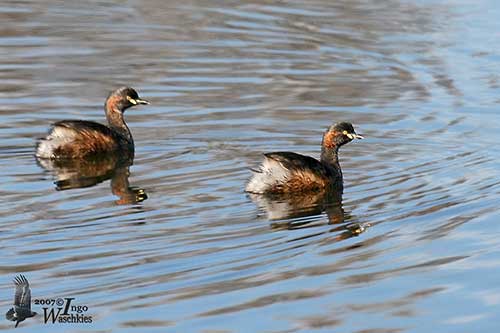
The Australasian Grebe is dispersive in the arid Australian regions. The northern population is migratory and the E and SW populations are probably resident. During the dry years, some of them may move towards the coast.
This species is a recent coloniser of New Zealand (the first breeding record was in Diamond Lake near Wanaka in 1977). Small breeding populations are established around Northland.
These movements indicate that long-distance flights are performed by this species, probably at night, with ringing records revealing movements of 338 km.
Like in other grebes, the take-off requires a long running over the water surface, but this species is a fairly good flier despite the short, weak wings. The flight is high and buoyant, with the feathers fluffed out, giving the bird a rotund shape.
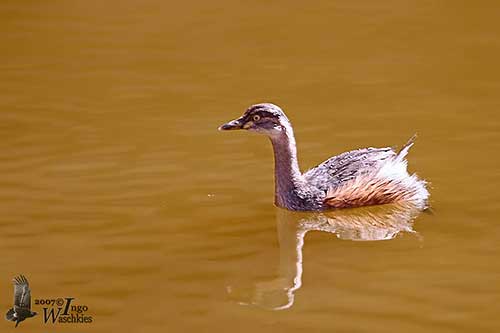
REPRODUCTION OF THIS SPECIES:
The breeding season is related to water levels. The laying occurs between August and April on temporary waters, whereas on permanent waters, it occurs mainly in September/November in SE Australia. The species may breed all year round in tropical regions.
The Australasian Grebe is solitary nester. The nest is a floating mound of vegetation usually anchored to a submerged plant, branch or reeds.
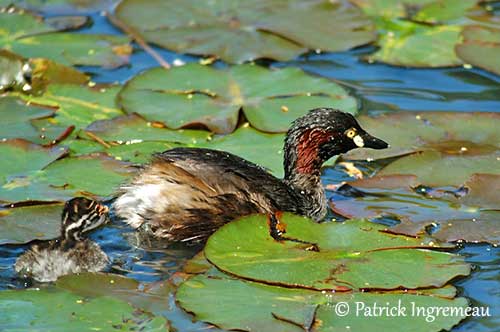
The female lays 4-5 pale eggs becoming reddish-brown in the humid nest. Both adults share the incubation during 23 days, and they rear the chicks during 8 weeks. The chicks can be seen riding on adult’s backs during the first weeks.
This specie usually produces 3 broods per season. When the parents start breeding again, the young are driven away.
